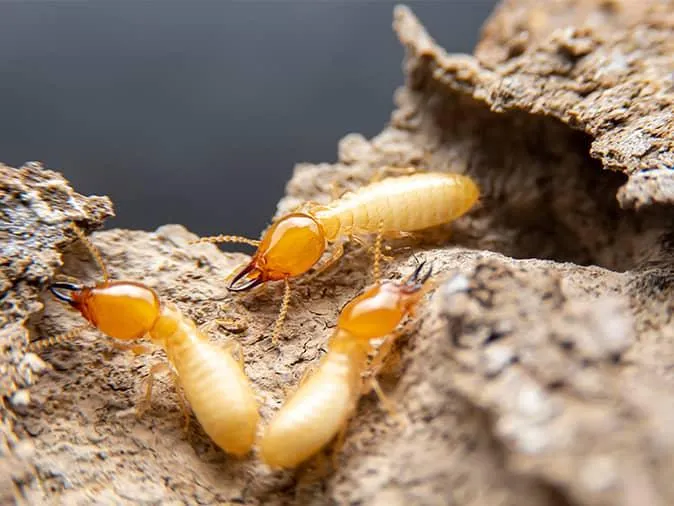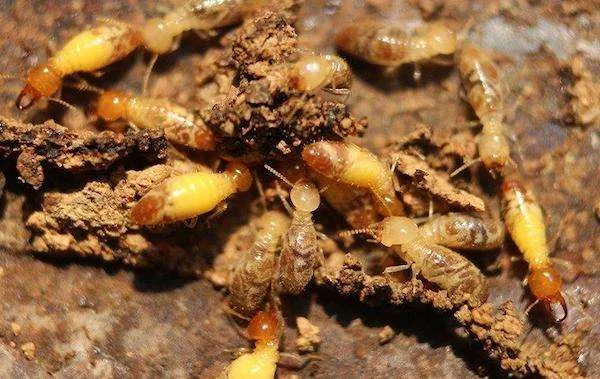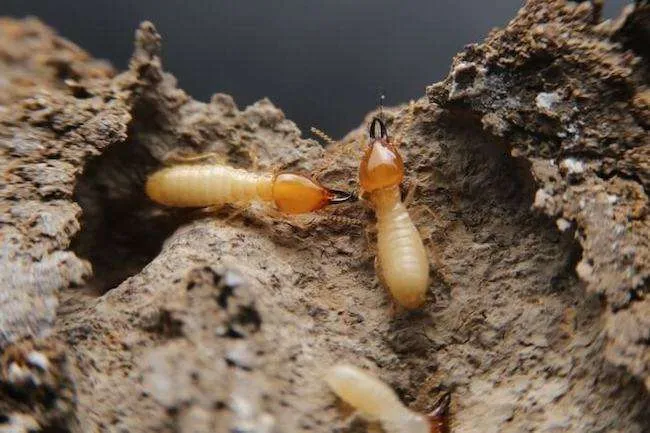You cannot hear termites because their sounds are too quiet and high-pitched for your ears to detect without specialized equipment.
Here’s why you can’t hear the Termites
- Termites produce sounds at frequencies humans can’t hear.
The sound range of termites typically falls between 3 Hz to 1,200 Hz, while the human audible range is approximately 20 Hz to 20,000 Hz.
- Their noises are often inaudible due to high-pitched vibrations.
- These vibrations are used only for communicating within the colony.
- Environmental sounds mask termite noises.
- Human ears lack sensitivity to their frequency range.
- Termites primarily communicate through other means, like pheromones.
The Silent Nature of Termites

A. Termites: The Silent Destroyers
Termites are called “silent destroyers” because they can seriously harm structures without anyone noticing for a long time.
Unlike other pests that may generate noise or visible signs of infestation, termites operate quietly and discreetly.
No Audible Sounds: Termites do not create audible sounds that humans can easily detect. Unlike rodents or insects like bees, which can produce buzzing, chewing, or scuttling noises, termites operate in near silence.
Hidden Activities: Termites mainly feed on wood from the inside out, making it challenging to detect their presence. Termites eat wood’s main part, cellulose, without showing visible damage on the surface.
B. Termites’ Ability to Hide Their Presence and Damage
Subterranean Tunnels: Subterranean termites build mud tubes to travel between their underground nests and food sources. These tubes are hidden from view, protecting termites from predators and environmental conditions.
Dampwood and Drywood Termites: Dampwood and drywood termites create galleries and tunnels within the wood. These tunnels are concealed within the wooden structures they infest, making it difficult to detect their activity without invasive inspections.
Slow and Steady Damage: Termites feed slowly, which means they may cause substantial damage over time without immediate notice. It can take months or even years before the effects of their infestation become apparent.
No Visible Entry Points: Termites can enter structures through tiny cracks or gaps in foundations, walls, or roof structures. These entry points may not be visible to homeowners, allowing termites to access the building discreetly.
Minimal Surface Damage: Unlike carpenter ants, which leave visible sawdust or wood shavings, termites consume wood internally, leaving the surface intact. This hidden damage can weaken structural integrity without visible cues.
Nocturnal Behavior: Many termite species are active at night, further reducing the chances of homeowners detecting their presence.
In conclusion, termites are rightly called “silent destroyers” due to their ability to operate quietly and discreetly.
They create no audible sounds, hide their activities in concealed tunnels, and slowly and steadily damage structures from the inside out.
Identifying Termite Sounds
A. Description of Different Termite Sounds
While termites are generally known for their silent nature, they do produce some subtle sounds during their activities. Understanding these sounds can help detect their presence.
Rustling Sounds: Termites can produce rustling or faint tapping sounds when they move within their tunnels and galleries. These noises are often very quiet and may not be heard easily.
Head-Banging: Soldier termites may create head-banging sounds by tapping their heads against the tunnel walls to warn the colony of potential threats. This sound is typically too soft for human ears to pick up.
B. Examples of Unique Termite Noises
Tapping and Clicking: Some termite species, like dry wood termites, can tap or click sounds while tunneling through wood. These sounds are usually quite faint and challenging to hear without specialized equipment.
Hissing Sounds: In response to threats, certain termite species, such as Nasutitermes costalis, can produce hissing sounds by expelling air from their bodies. However, these sounds are still very subtle and rarely detected by humans.
How to Detect Termite: Tips on How to Listen for Termite Sounds
Detecting termite sounds can be challenging due to their faint and infrequent nature. However, if you suspect a termite infestation, here are some tips on how to listen for potential sounds:
Quiet Environment: Ensure the area is quiet, free from other background noises that could mask any faint termite sounds.
Use a Stethoscope: A stethoscope or a sensitive microphone can be used to amplify faint sounds within walls or wooden structures. Slowly move the stethoscope or microphone along suspected infestation areas, such as walls, wooden beams, or floors.
Listen at Night: Some termites, like subterranean termites, are more active at night. Try listening for sounds during the evening when the environment is generally quieter.
Professional Inspection: If you suspect a termite infestation but cannot confirm it through sounds alone, it’s advisable to seek the expertise of a pest control professional. They can inspect thoroughly using special tools like acoustic detectors.
In summary, termites are typically quiet insects, and their sounds are very subtle and challenging for humans to detect without specialized equipment.
While there are instances of tapping, clicking, or hissing noises associated with termites, these sounds are often too faint to be heard unaided.
The Significance of Termite Sounds

A. Importance of Being Aware of Termite Noises as an Early Warning Sign
Early Detection: While termite sounds are generally subtle, they can serve as a crucial early warning sign of a potential infestation. Recognizing these sounds allows homeowners to take timely action.
Prevent Extensive Damage: Identifying termite infestations in their early stages can prevent extensive structural damage. Unchecked termites can cost homeowners thousands in repair bills due to significant damage.
Lower Treatment Costs: Prompt detection of termites often leads to more cost-effective treatment options. Early intervention can minimize the extent of infestation, reducing the need for extensive and expensive treatments.
B. Benefits of Detecting and Addressing Termite Infestations Promptly
Preservation of Property: Quick action helps preserve the integrity of the affected structure. Preventing termite damage ensures that the property remains safe and retains its value.
Health and Safety: Termite infestations can compromise the safety of a building. Timely detection and eradication prevent potential accidents or structural failures.
Peace of Mind: Quickly addressing termite infestations relieves homeowners of the stress and anxiety associated with the presence of these destructive pests.
Cost Savings: Early detection and treatment of termites are more cost-effective than dealing with extensive damage. It can save homeowners substantial repair expenses.
Environmental Impact: Some termite control methods are more environmentally friendly when applied on a smaller scale. Prompt intervention reduces the need for large-scale pesticide treatments.
Prevent Spread: Addressing termites and taking quicker action against them can stop them from spreading within the building or nearby properties.
In conclusion, being aware of termite noises and recognizing them as early warning signs is vital for homeowners.
Detecting and addressing termite infestations promptly can prevent extensive damage, save money, preserve property value, ensure safety, and provide peace of mind.
Early intervention is the key to mitigating the destructive impact of termites on homes and buildings.
FAQs
Can you hear termites eating wood?
No, you cannot hear termites eating wood because their sounds are too faint and at a frequency outside our hearing range.
Do termites make any noise at all?
Termites can produce soft clicking or rustling sounds when disturbed, but these noises are faint and seldom heard.
Can you hear termites in the walls of your house?
No, you typically can’t hear termites in the walls of your house because their chewing sounds are very soft and often masked by the structure’s materials.
Are there any specific tools to detect termite sounds?
Yes, there are specialized tools like acoustic detectors and microphones that can help you detect termite sounds in structures, although professionals often use them for accurate detection.
What sounds do termite soldiers make?
Termite soldiers may make faint clicking noises when they feel threatened, which is a defensive behavior to deter predators.
Can termites communicate with sound?
Yes, termites can communicate with each other through sound, using vibrations and head-banging to convey information within their colonies.
Do termites make noise when swarming?
Yes, termites can make a rustling or buzzing noise when they swarm, primarily due to their wings rubbing together, which is more noticeable in larger swarms.
Are termites noisy when tunneling through wood?
No, termites are not noisy when tunneling through wood; their chewing and tunneling sounds are very faint and usually not audible to the human ear.
Can termites be heard in the attic?
No, termites in the attic are usually not audible to you because their sounds are typically very soft and difficult for the human ear to detect.
What should I do if I suspect termite activity but can’t hear them?
If you suspect termites, look for visible signs of infestation like mud tubes, damaged wood, or discarded wings. It’s also advisable to consult a pest professional for a thorough inspection.
Conclusion
In conclusion, the blog post provides readers with an overview of whether or not termites can be heard.
While humans cannot directly hear termites due to their small size and the frequency of their sounds, detecting termite activity through sound is important for early detection and prevention of potential damage to homes or structures.
Understanding the signs and symptoms of termite infestations, including any audible cues, can help homeowners take prompt action to protect their properties and minimize potentially costly repairs.

